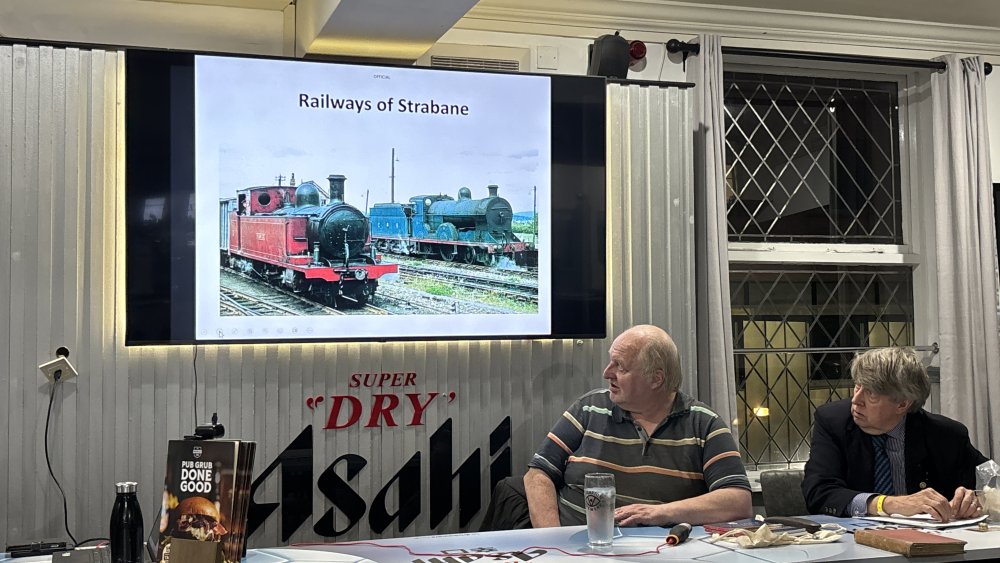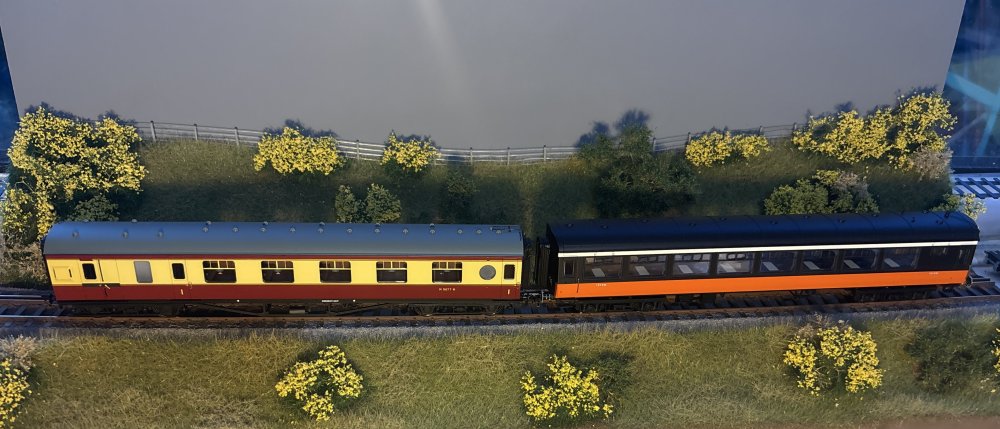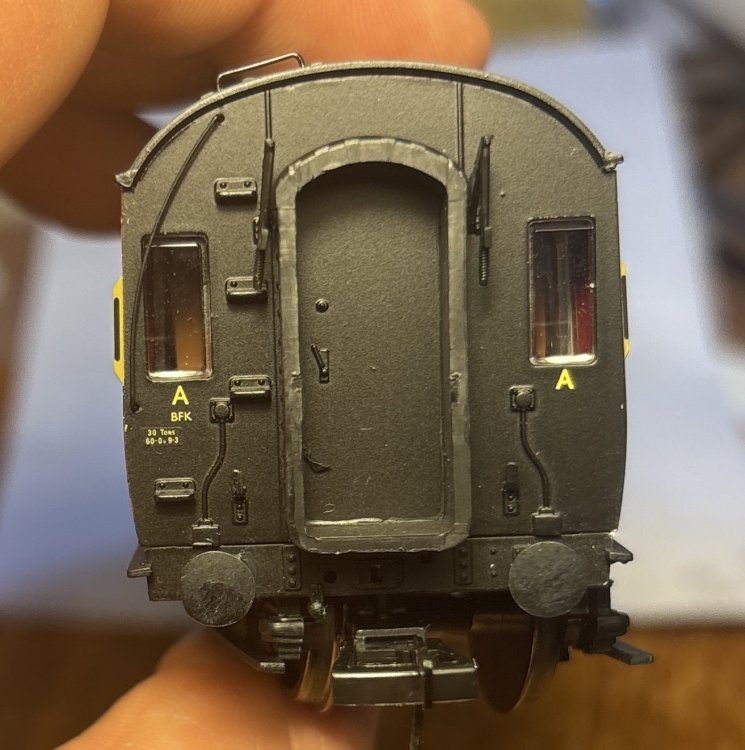
Mol_PMB
Members-
Posts
1,984 -
Joined
-
Last visited
-
Days Won
105
Content Type
Profiles
Forums
Resource Library
Events
Gallery
Blogs
Store
Community Map
Everything posted by Mol_PMB
-
Many thanks John, that’s very helpful.
-
Super attention to detail. Add a couple of firsts and a gen van and you have the Wexford Opera Train!
-
An excellent talk this evening by @airfixfan of this parish - many thanks! Two for the price of one really - a fascinating review of the effect of partition on all the cross-border lines and communities, followed by a focus on Strabane. Thanks again! The IRRS has branches in Manchester and Cork as well as the better-known Dublin and London centres. Talks are available online too. See the IRRS website for details of the local programmes.
-
It's taken me a while to get these physically complete, but I've finally achieved it this afternoon. With a brief sunny spell between the torrential storms, I was able to get a few photos. Trio: GNR vac-fitted: GNR unfitted, sides overlaid with sheeting: MGWR convertible (tarpaulin will be added after painting): They are now having a good wash and dry, and will then move on to the paintshop stage. But that's for another day - I might see one or two of you in the Waldorf this evening?
- 41 replies
-
- 10
-

-
Rapido seem to be having a splurge of new annoucements recently, including several classes of pre-grouping 4-4-0 locos: https://rapidotrains.co.uk/product-category/uk/oo-gauge/oo-locomotives/lner-d40/ https://rapidotrains.co.uk/product-category/uk/oo-gauge/oo-locomotives/secr-g-class/ https://rapidotrains.co.uk/product-category/uk/oo-gauge/oo-locomotives/hr-loch-class/ https://rapidotrains.co.uk/product-category/uk/oo-gauge/oo-locomotives/mr-483/ Whist not directly relevant to Irish modelling, some of these might be useful conversion fodder, or provide good chassis for 3D-printed Irish bodies. At a push some could be repainted in Irish livery and be 'close enough'. The most recent announcement (the GNoSR / SECR type) has some features in common with the MGWR A class, for example. The cab and firebox would need some work...
-
Newly uploaded to the IRRS archive, this shows a 3-car AEC railcar set hauling another bogie carriage, in 1961: https://www.flickr.com/photos/irishrailwayarchive/54778381281 However, this may be slightly-off-topic as I think this is a former GNR AEC set (600N class) rather than a CIE railcar. That may help to explain the hauled carriage, as the through-wiring for the GNR railcars was not directly compatible with the CIE railcars.
-
Making an ‘E’ – the Maybach Diesel Model Assembly thread
Mol_PMB replied to Mol_PMB's topic in Irish Models
There are some more E401 class photos in the latest batch of IRRS photos uploaded by Ciaran. These are the ones where the loco is actually a main subject, there are more where they pop up in the background. Mostly these are early 1970s, black or BnT livery, before the exhaust cowls were removed: https://www.flickr.com/photos/irishrailwayarchive/54778606939 https://www.flickr.com/photos/irishrailwayarchive/54777524327 https://www.flickr.com/photos/irishrailwayarchive/54778380831 https://www.flickr.com/photos/irishrailwayarchive/54778606924 https://www.flickr.com/photos/irishrailwayarchive/54778380866 https://www.flickr.com/photos/irishrailwayarchive/54777524317 https://www.flickr.com/photos/irishrailwayarchive/54778614868 https://www.flickr.com/photos/irishrailwayarchive/54778614908 https://www.flickr.com/photos/irishrailwayarchive/54778714950 -
Bogie flat wagons with steel floors 30091-30098 - photos?
Mol_PMB replied to Mol_PMB's question in Questions & Answers
Thanks to Ciaran at the IRRS Archives, a super selection of views of these wagons when new. I really must get on with building my model of one! https://www.flickr.com/photos/irishrailwayarchive/54778714835 https://www.flickr.com/photos/irishrailwayarchive/54778607654 https://www.flickr.com/photos/irishrailwayarchive/54778607924 https://www.flickr.com/photos/irishrailwayarchive/54777525192 -
G602 was still silver in mid-1963, there are several photos of it at Inchicore that summer including one with B177 (which helps to confirm the photo dates) https://www.flickr.com/photos/irishrailwayarchive/54255052946/ https://www.flickr.com/photos/irishrailwayarchive/53511153446/ https://www.flickr.com/photos/irishrailwayarchive/54419865730 Highly unlikely it would have been painted green after that date, especially considering that Inchicore had already painted the new G611s from green to BnT. I have not seen any photos of G601 or G602 in green. If they exist, I’d love to see them.
-
Indeed. And a timely reminder that subs are due this month.
-
There's another big upload at the IRRS photo archive on Flickr - several hundred new images: https://www.flickr.com/photos/irishrailwayarchive/ (as usual, you need to be an IRRS member to view them) Many from the 1960s and 1970s. Plenty for those who like the black and tan livery on diesels, some lovely E class pics and quite a few G and K class too. Plus all the more common types. Some interesting views of the early days of NIR. Some excellent photos of Fenit. Newly-delivered rolling stock and parts at Inchicore, and newly-built ones including bogie flat wagons A very nice selection of AEC railcars. Plenty of treats for me, and hopefully something in there for everyone. I'll spend some time working through them over the next week or two and update some of my threads and livery tables as appropriate. Thanks Ciaran!
-
There's a wonderful atmosphere on this railway. It's really naturalised into the landscape. Superb work!
-
Yes, that does look fairly good, I suppose the regular heavy freight traffic has ensured that it has been kept in fair condition. Hopefully the weedspray will continue to run.
-
Indeed. The rails, sleepers, ballast and subgrade/drainage would have been far from perfect towards the end of the line's operational life, and after decades of rot, corrosion and vegetation growth it would have all needed to be dug out and started afresh. That's a big and expensive job. The availability of second-hand materials cascaded from renewals on the main-line railway isn't as good as it was, owing to modern track-lifting practices tending to cut rails up on site. Modern track is also much heavier and less suited to manual methods of relaying.
-
Thanks! In the GNR wagon diagrams there's also a drawing for a similar type of turf wagon, a fairly standard open with creels. I'm sure that somewhere I've seen a photo of a turf train with a mix of those open wagons and the converted carriages.
-
In early anticipation of these etches, I have bought a couple of donor vehicles - a cheap one (£10) and a moderately-priced one (£35). Only the latter has arrived so far. The sides were originally intended for the Dapol 60' Stanier coach kits, but these are out of production and are very hard to find. Similar RTR options are the Airfix/Mainline/Dapol 60' Stanier composite, or the Bachmann 60' Porthole brake first. Most other Stanier/Porthole coach models are 57' long, or in the case of the Porthole composite it's the right length but has an unusual cross-section profile and a different style of underframe. So here's the moderately priced donor, the Bachmann brake first, seen with something a bit more Irish: This is quite a nicely detailed model, rather better than the old Airfix one. It also has power pickups from the metal wheels, and kinematic couplers. Seems a shame to sand it all off, but needs must... The cross-section of these Porthole coaches ought to be like this: I did a few dimensional checks and I estimate the model is pretty close in width - it scales out at 9'0" over footsteps, 9'0" at waist, 8'10" over gutters and 8'8" just below the gutters. Height-wise it seems to be riding almost 1mm too low but that can be corrected by packing the bogie pivots a fraction. Now, how does that compare to the CIE coaches built in the 1951-1953 period, which the etched sides represent? I haven't actually found any dimensioned diagrams/drawings for these (has anyone got one squirreled away?) The best I've got is this which is entirely undimensioned except for the lining and lettering: However, the carriage registers and some other sources give dimensions. Confusingly they are not always consistent, and I suspect that may be how they are defined. Is 'Width' over the bodysides, or the door handles or the duckets? Is 'Height' to the roof surface or to the highest ventilator or water pipe? The carriage registers say that the Maximum Width of these carriages is 9'11 1/4", which I think is a genuine maximum. Pender & Richards and the IRT&T books give the width as 9'6" and I think that is the width over the body sides. The model is about 2mm too narrow at the waist, and about 3mm too narrow just below the gutters. But I'm going to overlay some new brass sides which will make up about half that discrepancy. More obvious from the ends is the slight taper on the upper body sides, which may or may not be worth trying to correct as it's not obvious from most viewing angles. The carriage registers say that the Maximum Height is 12' 9", which if it represents the height over the vents (I think it does) is very close to the LMS carriage, if the model's ride height is raised a fraction. Probably the biggest discrepancy is the roof profile, which on the CIE coaches is vertical at the gutters, then filleted into a shallow arc over the top of the roof. The LMS roof is more elliptical. I may do some experiments with making an alternative roof that is closer to the CIE profile. An alternative would be to build up the edges of the existing one and sand it back, but I suspect it would be very difficult to get an even shape. Or I just accept the LMS shape as 'good enough'. When my cheapy Airfix coach turns up I'll do some similar measurements. I'm in no hurry to start hacking at them - the brass sides are some months off and I have plenty of other things to be working on.
-
The same thought went through my mind, but I wasn't quite brave enough to write it down. I suppose at least you're leaving it to the reader to decide whether the 50% overlap refers to 'comprehensible' or 'gibberish'...
-
Interesting. The photo above shows quite clearly that the conversion was more involved than just taking out the roof and seats. The sides were also reconfigured to provide double doors which were presumably used for emptying them. Note the repositioned doors still carry their old 3 class designations resulting in the appearance of 33 from the two passenger doors now re-hung side by side as a pair of double doors. Has anyone here made a model of such a train?
-
I bought the earlier volumes from the RPSI, I imagine they will have this one as well in due course.
-
It will also be interesting to see whether this set of Bulleid opens reaches the prices being asked for new ones: https://www.ebay.co.uk/itm/205711355204
-
Interesting. The one I got recently cost £250.28 (Buy It Now) and was up for sale for a week before I bought it. My seller seemed to be a private individual without much of a history on eBay (only a few bits of feedback) so it might have looked risky, but I asked some questions and came to the conclusion they were legit. It was sold as DCC sound fitted, but it wasn't (it did have a plain DCC chip), and when I found this I asked for (and got) a £50 refund. I know the sound chip costs more than that, but I reckoned about £200 was a fair price. We'll soon see what others think is a fair price for a green one - it's up to £215 already.
-
FREMO modular layout - polish rail PKP
Mol_PMB replied to Jack_Dunboyne's topic in Continental European Modelling
Excellent work! -
Lovely job - that really looks the part. I hope they're not going to disrupt the sermon next door!
-
Sorry! You'll just have to buy a train of each... They're not much more expensive than H vans!
-
The top skips increased the volume and so allowed the wagons to be loaded to maximum axleload even with slightly less dense grades of coal. They also much reduced the amount of coal blown off the wagons en route - as well as losing payload this contaminated the ballast and wasn't popular with the neighbours. (These wagons carried very fine coal, little more than dust, for power station use.) But as you say, they weren't compatible with most collieries and most of the top skip fitted wagons worked in Scotland for much of their lives. Wagons with and without top skips would not normally be mixed in service.
.png.c363cdf5c3fb7955cd92a55eb6dbbae0.png)








